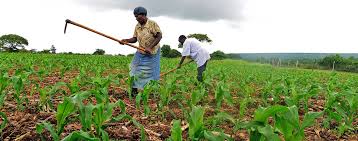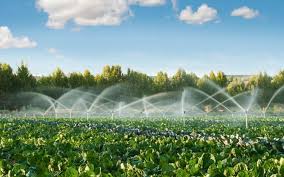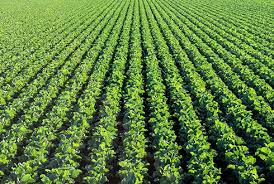Irrigation water is applied for crops to use in their growth and development. However, not all the water applied is used up by the crop, and the amount used or the uptake of the irrigated water depends on the evaporation and transpiration of water from the soil surface and leaf surface respectively. This article discusses water use by crops for physiological processes and water loss through evapotranspiration.
Meaning of Consumptive Use in Agriculture
Water is transferred to the atmosphere by direct evaporation of water from soil and plant surfaces as well as by transpiration. Since these processes are not easily separated, they are combined and called evapotranspiration.
Consumptive use includes water used in all physiological processes as well as direct evaporation from soil surface and plant surfaces.
The consumptive use exceeds evapotranspiration by the aporaphotosynthate, structural support and growth. Since this difference is less than 1%, evapotranspiration and consumptive use are normally assumed to be equal.
Read Also: How to Grow, Use and Care for Whitetinge Sedge Grass (Carex albicans)
Types of Consumptive Use in Crop Production

1. Daily Consumptive Use:
This is the total amount of water used by crop for evapotranspiration (transpiration and evaporation) in 24 hours or in a day. This varies with plant stage of growth from germination to senescence. At germination it is low, and when the plant is fully developed it increases and later decreases at senescence (leaf dropping).
2. Seasonal Consumptive Use:
This is the total amount of water used by the crop for evapotranspiration through the growing season of the crop. It is the sum total of daily consumptive use of a crop from germination to harvesting.
3. Peak Consumptive Use:
This is the average daily consumptive use within 6–10 days of the highest consumptive use of the season. It is highest at harvest time. For irrigation purpose, peak consumptive use is used instead of daily consumptive use because daily consumptive use varies with the growth stage of the crop.
For crop that requires 3 months to grow and mature, in planning for irrigation water to be used, the peak consumptive use is multiplied by the number of days to maturity to get the total amount of the water required.
Evapotranspiration (ET) in Agricultural Systems
Evaporation is the escape of water in form of vapour from the soil to the atmosphere through wind. Transpiration is the escape of water in form of vapour from the plant stomata in the leaf to the atmosphere through wind.
These two processes are joined together and called evapotranspiration, which is the escape of water in the form of vapour from the plant and soil surface to the atmosphere through wind.
Evapotranspiration is affected by climatic factors such as sunshine, temperature, wind and rainfall. Soil fertility or organic matter, soil texture and amount of mulch materials on the soil, and factors such as types of crop, growth stage of the crop and size of crop leaf affect evapotranspiration.
Read Also: How to Grow, Use and Care for Whitegrass (Leersia virginica)
Determination of Evapotranspiration for Irrigation Planning

There are many methods used in determining evapotranspiration, but the most commonly used methods are:
1. Direct Methods Based on Conservation of Mass
The most widely used direct techniques are based on conservation of mass principles:
Ds = Drz (θf – θi)
Where:
Ds = changes in soil moisture within the control volume during the time interval being considered
Drz = Depth of root zone (below soil surface)
θf and θi = soil moisture content by volume at the end (final) and beginning (initial) of the time being considered
2. Calculated Methods of Evapotranspiration Using Crop Coefficients
All methods for computing crop evapotranspiration involve the following equation:
ET = Kc x ETo
Where:
ET = evapotranspiration (mm/day)
ETo = reference crop evapotranspiration (mm/day)
Kc = crop coefficient or crop factor
Reference crop evapotranspiration may be potential evapotranspiration or crop reference evapotranspiration. Potential evapotranspiration is the maximum rate at which water available can be removed from soil and plant surfaces.
Potential evapotranspiration depends on the amount of energy (sunlight) available for evaporation and varies from day to day. Reference crop evapotranspiration is the rate of evapotranspiration from a large area covered by green grass which grows actively, completely shades the ground, and which is not short of water.
Many methods with different data requirements and level of sophistication have been developed for computing reference crop evapotranspiration.
Some of these methods require daily relative humidity, solar radiation, wind and air temperature data, while others need only mean monthly temperature.
The crop coefficient “Kc” relates to the actual rate at which the crop is determined experimentally and relates to the physiology of the crop, the degree of the crop cover, the location where the data were collected, and method used to compute the reference crop evapotranspiration.
The value of crop coefficient for field and vegetable crops generally increases from an initial plateau to a peak plateau and then declines as the plant progresses through its growth stage.
3. Variation of Crop Coefficient with Growth Stages
Stage 1 = Initial stage (seedling development)
Stage 2 = Crop development (increase in water use)
Stage 3 = Mid-season (flowering to beginning of fruiting)
Stage 4 = Late season (fruiting to harvesting)
Using Pan Evaporation Data to Estimate Crop Evapotranspiration
Measuring the loss of water from an open-phase pan of water is a relatively inexpensive and simple way of assessing the evaporating capacities of the atmosphere.
The amount of water evaporating from a pan (that is pan evaporation) is determined by measuring the change in water level in the pan and correcting for precipitation if it has been prevented or is negligible.
Principles of the Pan Ratio Method
- The pan is installed in the field
- The pan is filled with a known quantity of water (surface area of the pan is known and the water depth is measured)
- The water is allowed to evaporate during a certain period of time (usually 24 hours); for example, each morning at 7:00am a measurement is taken. Rainfall, if any, is measured simultaneously
- The amount of evaporation per unit (the difference between the two measured water depths) is calculated; this is the pan evaporation: E pan or EP (in mm/day)
- The E pan is multiplied by a pan coefficient (K pan or Kp), to obtain reference crop evapotranspiration (ETo). Daily pan evaporation is routinely measured at weather stations using the formula:
ETo = Kp x Ep
Where:
ETo = reference crop evaporation
Kp = pan coefficient that accounts for differences in pan type
Ep = pan evaporation
Example of Daily Pan Evaporation Data
| Date | EP (mm) | ETo (mm) |
|---|---|---|
| July 1 | 12.2 | 12.2 x 0.8 = 9.76 |
| July 2 | 11.2 | 11.2 x 0.8 = 8.96 |
| July 3 | 8.4 | 8.4 x 0.8 = 6.72 |
| July 4 | 6.6 | 6.6 x 0.8 = 5.28 |
| July 5 | 9.7 | 9.7 x 0.8 = 7.76 |
| July 6 | 9.7 | 9.7 x 0.8 = 7.76 |
| July 7 | 8.1 | 8.1 x 0.8 = 6.48 |
| July 8 | 6.6 | 6.6 x 0.8 = 5.28 |
| July 9 | 8.6 | 8.6 x 0.8 = 6.88 |
| July10 | 5.8 | 5.8 x 0.8 = 4.64 |
Total EP = 88.3 mm
Total ETo = 70.64 mm / 10 days
Solution:
ETo = Kp x EP
Kp = 0.8
Daily ETo = 0.8 x daily EP
Example (July 1): ETo = 0.8 x 12.2 = 9.76 mm/day
Total ETo = EP x Kp = 88.3 x 0.8 = 70.64 mm/10 days
Importance of Consumptive Use and Evapotranspiration in Agriculture
The knowledge of consumptive use, evapotranspiration and reference crop evaporation is important in planning for irrigation. This guides the farmer to estimate crop water needs at different stages of growth, which enhances water use efficiency.
Do you have any questions, suggestions, or contributions? If so, please feel free to use the comment box below to share your thoughts. We also encourage you to kindly share this information with others who might benefit from it. Since we can’t reach everyone at once, we truly appreciate your help in spreading the word. Thank you so much for your support and for sharing!

